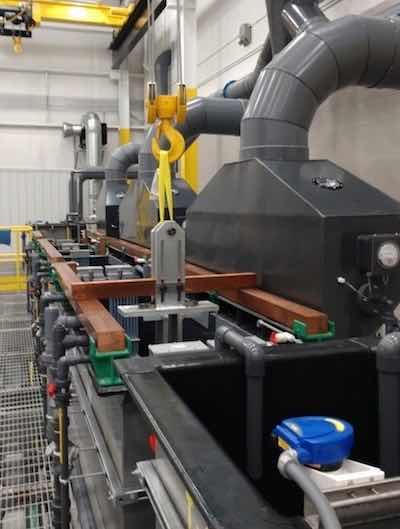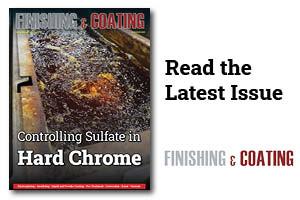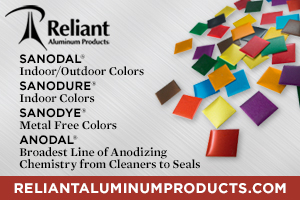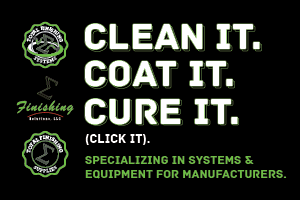A certain degree of governmental regulation is necessary in a civil society. However, the federal government expanded at an alarming rate and created agencies and departments for duties not authorized by the U.S. Constitution.
 Eric Svenson Sr.
Eric Svenson Sr.
Note: this opinion article is authored by Eric Svenson Sr., a Master CEF and IUSF member and CEO of Plating Resources. He has been in the electroplating industry since 1961, a 64-year career.
Those duties belong to the states and not the federal government. This transfer of legislative authority is an intrusion on states’ rights that lessens our freedoms.
Those bureaucratic actions damage our economy and often force successful businesses to close, sometimes sending entire families into unemployment and making them dependent on the government.
One overreach example is the U.S. EPA’s air emission standards that regulate the allowable amount of hex-chrome air discharges. These, along with OSHA’s PEL limits, are believed to be based on faulty assumptions from data in 1931 for chrome ore mining, chromate production plants, and plating operations back then. This was decades before ventilation and various safety measures were used. If true, the hex-chrome regulations are grossly overblown and don’t come close to representing the actual hazard.
The War on Hex-Chrome
Many in our industry feel they were singled out for punishment while much larger organizations could afford the expense of compliance. The larger companies didn’t complain because it reduced their competition and provided increased profits.
The regulation overreach has caused a reduction of over 50% in hard chrome operations in the U.S. since the 1980s. Sadly, this has affected many families of hardworking, productive Americans and our overall economy.
Unfortunately, our federal system has changed from capitalism to cronyism. Capitalism is based on a voluntary exchange that rewards businesses that meet people’s needs, with the customer deciding what succeeds and what fails. True capitalism drives improvements, innovations, efficiency, and lower costs. Cronyism, on the other hand, is where a business succeeds not based on efficiency or quality, but through political lobbying. Cronyism profits come from subsidies, bailouts, and regulatory efforts designed to crush the competition.
So how does cronyism relate to our industry? Some of the larger chemical suppliers are suspected of collaborating with the EPA to tighten the regulations and eventually ban hex-chrome plating. This is likely what’s behind the foolish effort to squash the hard chrome industry and adopt trivalent hard chrome or one of the several ‘replacement coatings,’ none of which provide a viable alternative.
The use of hexavalent hard chrome is vital to U.S. industries, our defense, and our economy. It must be saved at all costs.
This begs us to question the motive behind replacing hex-chrome plating: is it really about saving the environment, providing a safer workplace, or is it something else altogether?
The author’s opinion is that it’s actually about increasing profits for the larger chemical suppliers. It’s a fact that the so-called ‘replacement coatings’ are significantly more expensive, and their profit margins are much higher.
The bottom line is that the ‘powers’ are attempting to impose a more profitable process on our industry. What they couldn’t achieve through normal commerce, they are trying to accomplish through government intervention.
An Irreplaceable Finish
The move to replace hex-chrome plating is cronyism at its finest. The desire to drive excess profits overcomes any concern for our industry, our economy, or our environment. The ironic part is that these replacements are much more costly to apply and can increase the environmental impact. In many cases, the hazardous waste potential of the replacement coatings greatly exceeds that of hexavalent hard chrome when it’s properly applied.
A potential replacement should provide an improvement on what is currently being used; for hard chrome, this means the replacement should:
- Be just as hard or harder.
- Provide the same or better wearability.
- Have the same adhesion, ductility, and corrosion resistance.
- Use a similar and simplified activation sequence.
- It would be just as easy to control.
- Have a similar resistance to impurities.
- It would be just as easy to achieve zero discharge.
- Not generate excess waste products.
- Does not have additional equipment requirements.
- Have similar chemical and application costs
The truth is that none of the replacements provides these properties. Only hex-hard chrome can do this and has done so for many decades. Hex-hard chrome can now be safely plated with a properly designed system, and doing so won’t be a threat to the public, the workers, or the environment.
The use of hexavalent hard chrome is vital to U.S. industries, our defense, and our economy. It must be saved at all costs.
Industry Evolution
There’s a new sheriff in town, and this could lead to a softening of the EPA’s regulatory efforts and a reduction in some of the federal discharge limits. However, it would be reckless to make assumptions at this point. Therefore, the hard chrome platers need to adopt the technology for reducing their hex-chrome discharges to zero, or as close to that as possible. This includes their airstreams, liquid wastes, and employee exposures.
The next 5-10 years are expected to see continued consolidation within the job shop industry. Some shops will be acquired, while others will close when their owners retire or simply decide to retire. Shops operating with outdated equipment will struggle to compete, which will further drive consolidation.
These improvements mean that hex-hard chrome can now be applied with complete safety. A bonus is the increase in efficiency, resulting in more parts per hour. This lowers the application cost and increases income.
The larger and better-financed operations will continue operating and will benefit from this trend because of the reduced competition and increased work volumes that result. But that’s possible only if their equipment is updated and their processes are designed for maximum efficiency and environmental control.
This trend also means that OEMs who send out work for hard chrome plating will face increasing challenges in finding suitable job shops to meet their needs. This could lead to higher costs, slower delivery times, and in some cases, inferior quality. Some OEMs view this as an opportunity to bring their work in-house, where they can better control delivery, quality, and costs.
Moving Forward
 A modern and sustainable hard chrome plant.Several noteworthy improvements in equipment designs were made in recent years. The most notable involves making hex-chrome plating a truly safe and environmentally friendly operation. These developments include:
A modern and sustainable hard chrome plant.Several noteworthy improvements in equipment designs were made in recent years. The most notable involves making hex-chrome plating a truly safe and environmentally friendly operation. These developments include:
- Sustainable hard chrome with zero air emissions.
- Greatly reduced employee exposure.
- Advances in anodes and process efficiency.
- Improvements in bath agitation.
- Better materials for tank linings and containment coatings are needed.
These improvements mean that hex-hard chrome can now be applied with complete safety. A bonus is the increase in efficiency, resulting in more parts per hour. This lowers the application cost and increases income.
The sustainable hard chrome technology achieves a true zero discharge approach for hex-chrome in both water and air streams. In addition to using a specialized ventilation system, this also involves upgrading some of the related equipment components.
Another feature of this development is the reuse of all chromium-bearing process streams, which further reduces operational costs. So, how efficient is this development?
- Ventilation Hex-Cr Discharged: Zero (below detectable limits)
- Operators Breathing Air: 55-156 times below OSHA’s PEL
- Chrome Waste Generated: Zero
- Hex-Cr Soil Contamination: Zero
- Process Chemical Recovery: 100%
- Chrome Shop: Stayed clean of Cr misting.
These results were achieved during a certified EPA stack test while plating at 20,000 amperes for a full eight hours. Other features of the sustainable approach include:
- Sewer Connections: None
- Waste Treatment: Not needed
- Equipment Cost: Comparable with standard equipment
- Fume Suppressants: Not needed anymore
- Chemical Costs: The same or less than others
The containment design allows the recovery of any splashes or spills, which are returned to their processes for reuse; expensive recovery gadgets aren’t required. Fume suppressants aren’t needed, and the operators don’t need respirators. The elimination of fume suppressants provides additional savings and eliminates the need for constant surface tension measurements.
The EPA hasn’t yet recognized the practicality of using the sustainable hex-chrome design. This doesn’t bother the plating industry because with zero emissions, the regulators can tighten the discharge numbers all they want and it won’t affect them.
Fortunately, the hex-chrome process can never be banned in the U.S.A. because of its critical nature for defense, aviation, space exploration, and American commerce.
These developments provide an opportunity for both job shops and OEMs to upgrade their operations and adopt the current technologies for environmental safety and increased process efficiency. Companies with the foresight to do this will thrive in future years and will avoid being regulated out of business.
Eric Svenson Sr. is CEO of Plating Resources and a Master CEF and IUSF member. Visit www.Plating.com. If you have any questions or wish to explore this topic further, please contact Vicky at Vicky@Plating.com.



































